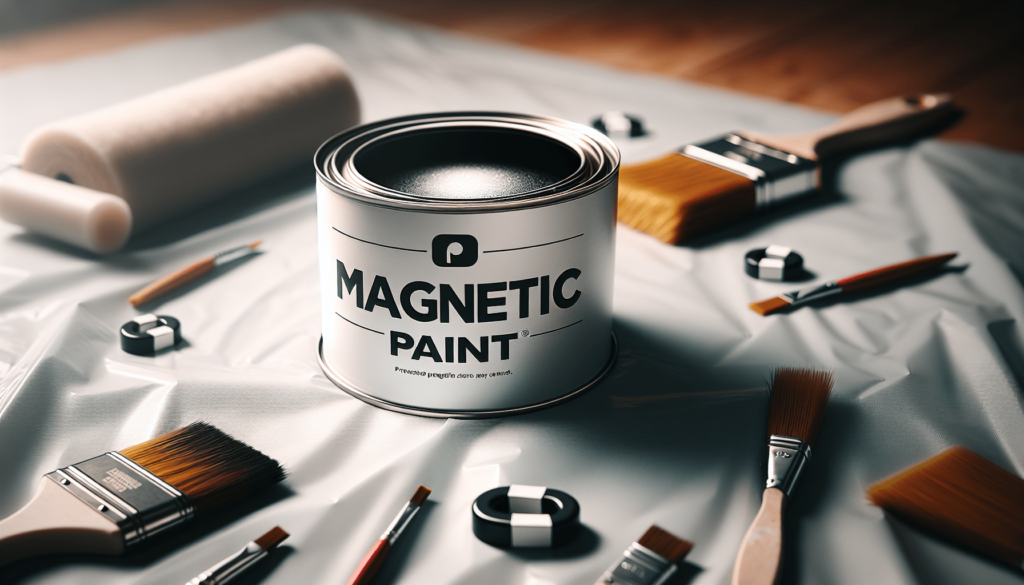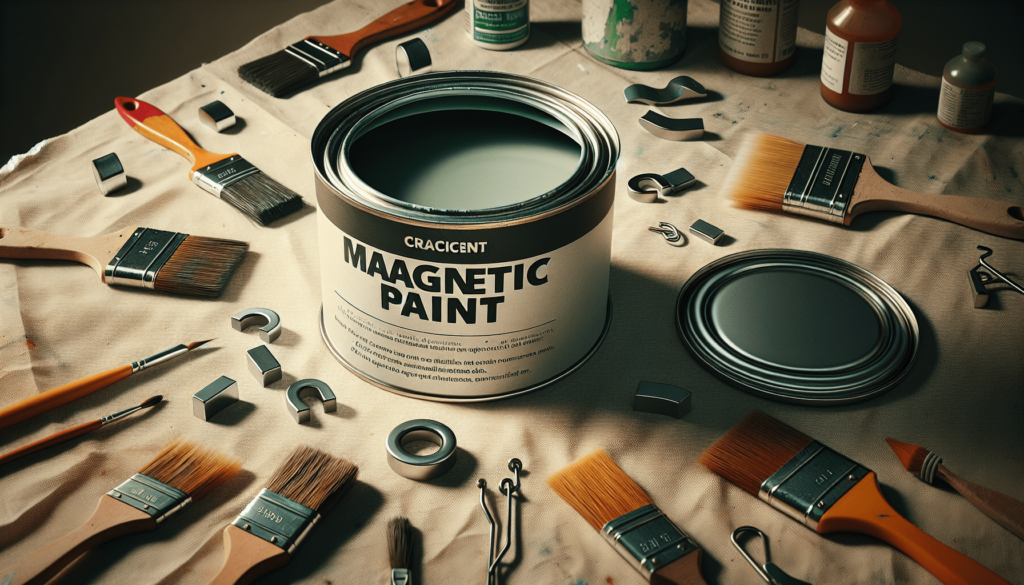Have you ever found yourself puzzled by a project that didn’t turn out as expected? You might have hoped to create a fun, interactive space with magnetic paint, only to find that it’s not working as effectively as you envisioned. Understanding why your magnetic paint isn’t functioning can ensure that your creative dreams become a reality.

What is Magnetic Paint?
Magnetic paint is a unique type of coating that allows magnets to stick to walls and other surfaces. This paint usually contains iron filings, enabling magnetic attraction, making it perfect for creating interactive surfaces in homes, offices, classrooms, and more. You might have chosen it for fun kids’ rooms, bulletin boards, or even creative art spaces.
How Does Magnetic Paint Work?
When applied, magnetic paint creates a surface that can hold magnets due to the presence of tiny ferrous particles within the paint. These particles allow the paint to attract magnets, which can then hold onto the painted surface. It’s a clever way to combine artistry with functionality, and it’s easy to see why you’d be excited to use it!
Reasons Why Magnetic Paint May Not Work
If you’ve applied magnetic paint and are disappointed with its performance, several factors could contribute to the problem. Let’s break them down so you can troubleshoot effectively.
Incorrect Surface Preparation
Surface preparation is one of the most crucial steps when applying any paint, including magnetic paint. If the surface isn’t clean or smooth, you might not get the best results.
Tips for Proper Surface Preparation:
- Clean the Surface: Ensure that the surface is free from dust, dirt, grease, and moisture. A clean surface allows better adhesion.
- Sand the Surface: If you’re applying on a wall that has a textured or rough finish, consider sanding it down to create a smoother finish. This can enhance the paint’s effectiveness.
Insufficient Number of Coats
You might think that just a single coat of magnetic paint will suffice, but that often isn’t the case. The number of coats applied can significantly affect the performance of the magnetic surface.
Recommendation: Generally, it’s advised to apply at least three coats of magnetic paint for optimal magnetic strength. Each coat should be allowed to dry thoroughly before adding the next layer. This layered approach helps to build up the magnetic field strength.
Type of Magnets Used
Not all magnets are created equal. The effectiveness of magnetic paint can also depend on the type of magnets you’re using.
Recommended Magnets:
- Neodymium Magnets: These strong magnets are often more effective with magnetic paint compared to standard ceramic magnets. If you’re using lower-quality magnets, you might find that they don’t hold as well.
Paint Thickness
The thickness of the paint layer can affect not only the appearance but also the functionality of magnetic paint.
Understanding Paint Thickness:
- If the paint is applied too thinly, it may not hold enough ferrous particles to create a strong magnetic bond. On the flip side, applying it too thick can lead to unevenness. Striking a balance is key.
Environmental Factors
The environment in which the magnetic paint is applied can also affect its effectiveness.
Temperature and Humidity
Environmental conditions play a significant role in how paint performs.
Ideal Conditions:
- Temperature: It’s best to apply magnetic paint in a well-ventilated area at room temperature. Extremely cold or hot conditions can affect drying and adhesion.
- Humidity: High humidity can impact the drying time and the performance of the paint. Ideally, aim for a humidity level below 70% when painting.
Quality of Magnetic Paint
Like all products, the quality of magnetic paint can vary between brands. Using a lower-quality paint might result in less effective magnetic properties.
Choosing the Right Product
When shopping for magnetic paint, it’s beneficial to do some research. Look for reputable brands with good reviews and proven results. High-quality paint with a higher concentration of iron filings will typically perform better.

Application Technique
The way you apply the paint can greatly influence the final outcome.
Using the Right Tools
The tools you use to apply the magnetic paint can determine how evenly it spreads and how effectively it adheres to the surface.
Recommended Tools:
- Rollers or Brushes: A roller is often the best choice for an even application, but if you’re working in smaller or intricate areas, a brush might be necessary. Ensure your tools are clean and dry before use.
- Edging Tools: If your project involves corners or edges, consider using painter’s tape or an edging tool for a cleaner finish.
Application Method
The method you choose to apply the paint can affect its performance. For best results, follow the recommended application methods provided by the manufacturer.
Maintenance and Care
Once the magnetic paint is applied, proper care is essential to ensure its effectiveness over time.
Regular Cleaning
Regular maintenance can help you keep the surface clean and functional. Dust and debris can accumulate on the surface, impacting the adhesion of magnets.
Cleaning Tips:
- Use a damp cloth to gently wipe down the painted surface without scrubbing too aggressively, which can damage the paint.
Avoid Overloading the Surface
While magnetic paint is designed to hold magnets, there’s a limit to how much weight it can support.
Guidance on Weight Limits:
- Be cautious not to overload the surface with heavy objects. This can cause the magnets to peel away from the paint. Assess the weight of the items you plan to attach and ensure they’re within the limits that the magnetic paint can handle.
Troubleshooting Common Issues
Even if you’ve taken all the right steps, you might still encounter issues. Here are some common problems and potential solutions.
Weak Magnetism
If you find that your magnets are not holding as strongly as expected, there are a few steps you can take to troubleshoot.
- Reassess the Coats: Check the number of coats you’ve applied. If you’ve applied fewer than three coats, consider adding more.
- Try Different Magnets: Switch to neodymium or stronger magnets, which can offer better performance than regular magnets.
Paint Peeling or Flaking
If you notice the paint peeling, there might be a few reasons for this.
- Check Surface Preparation: Lack of proper surface preparation can lead to adhesion problems. Ensure that the surface was adequately cleaned and primed before application.
- Environmental Conditions: Look into the humidity and temperature factors when initially applying the paint, as adverse conditions can lead to peeling.
Enhancing Your Magnetic Wall
Once your magnetic paint is successfully working, you might want to make the most of your new creative space.
Decorative Options
Consider adding a layer of regular paint on top if you’d like to enhance the aesthetics of your magnetic wall. Just ensure it’s compatible with your magnetic paint so that it doesn’t interfere with magnetism.
Functional Uses
Think about how you might use your magnetic wall in everyday life. Here are a few ideas:
- Create a place to temporarily display kids’ artwork or school projects.
- Use it for planners and reminders – simply attach notes with magnets!
By incorporating magnetic paint meaningfully into your space, you can enjoy both its functionality and decorative appeal.
Conclusion
Understanding why your magnetic paint might not be performing as expected can lead you to a more enjoyable and successful project. By addressing surface preparation, the quality of paint, application methods, and the tools used, you can enhance the efficacy of your magnetic paint. Remember that patience and diligence during both installation and maintenance will yield the best results.
Before you start your next project, make sure you’ve checked all these factors. Then, sit back and enjoy your new versatile space filled with possibilities, creativity, and of course, a bit of magnetism!



